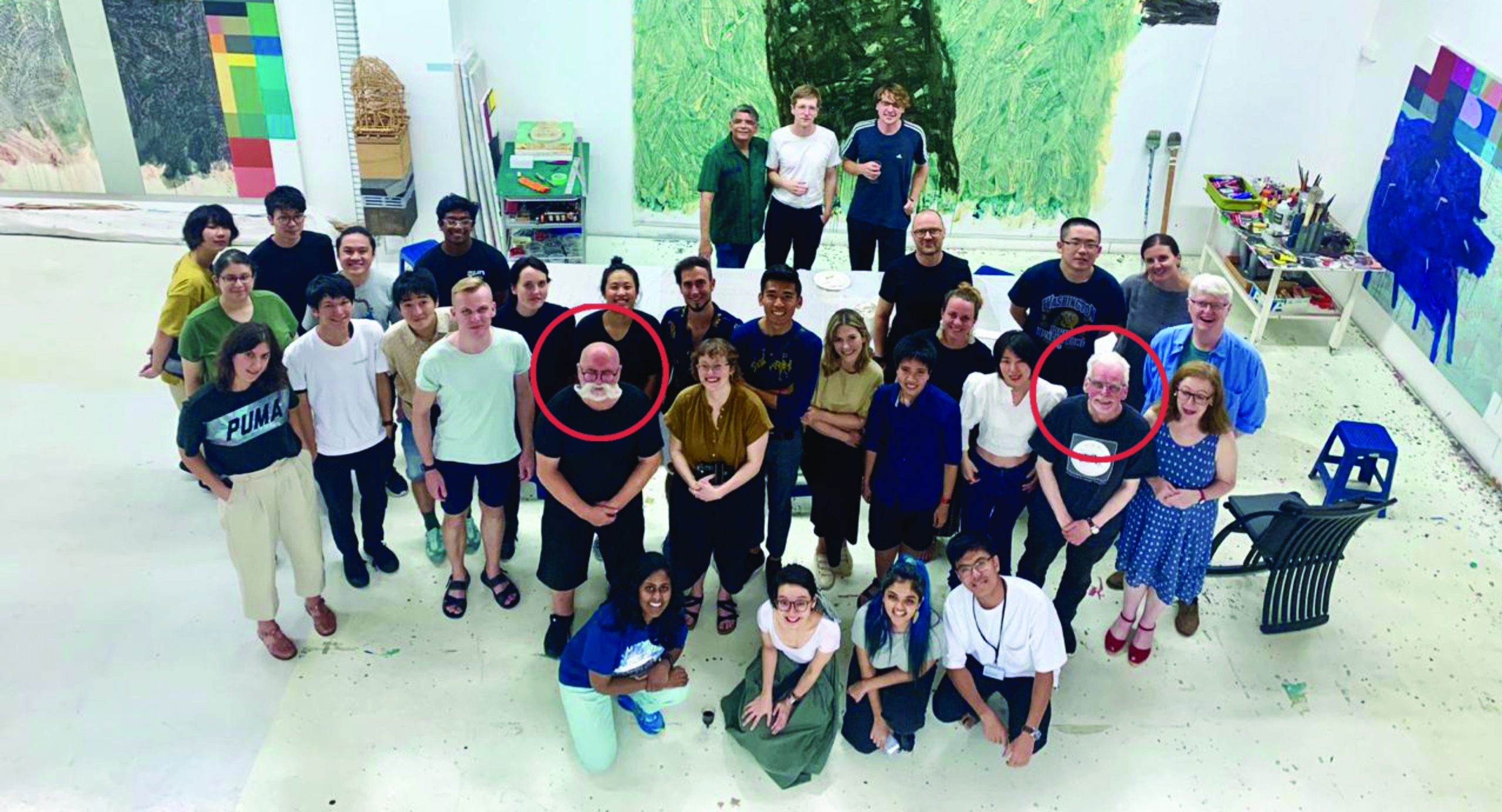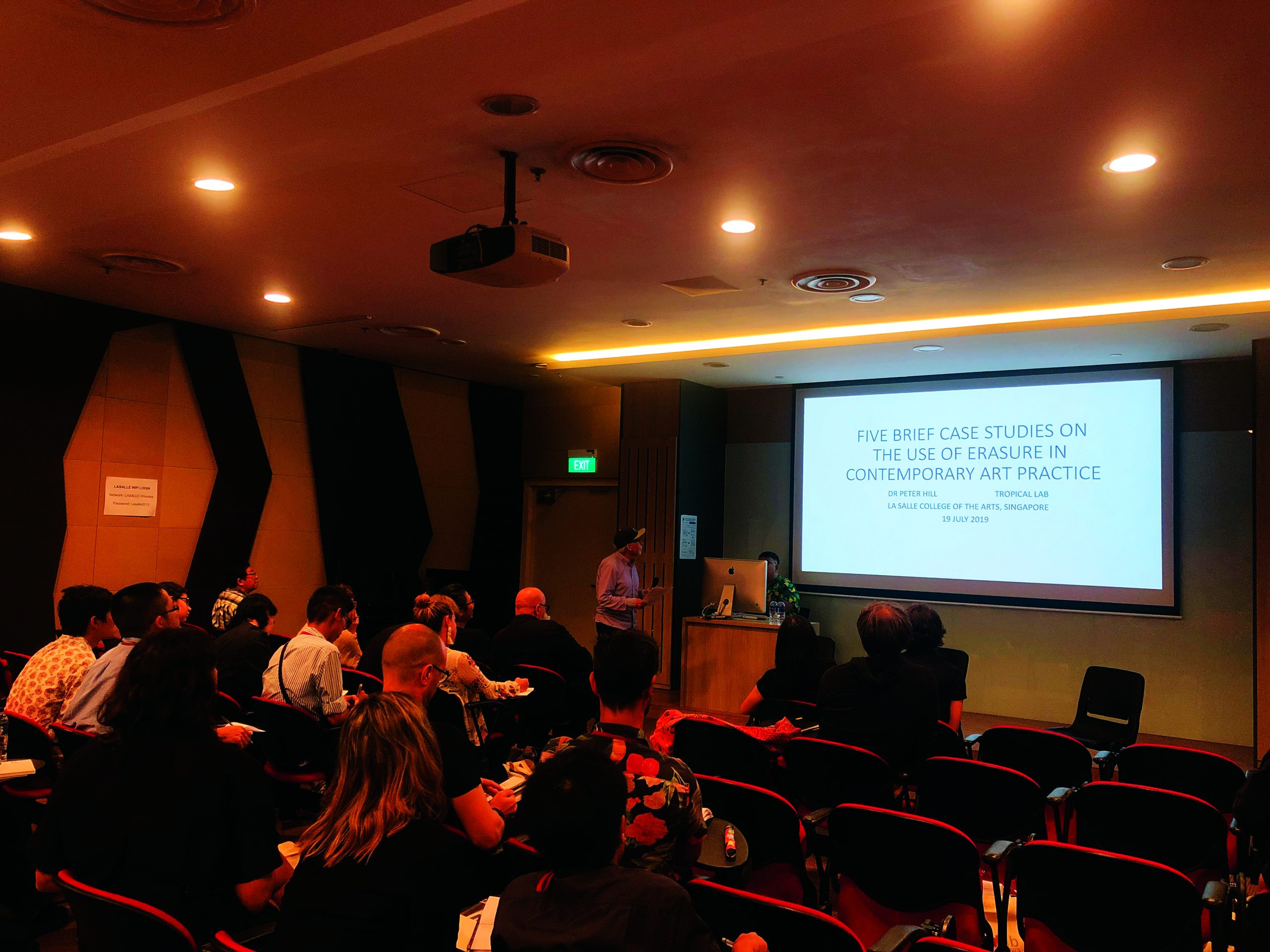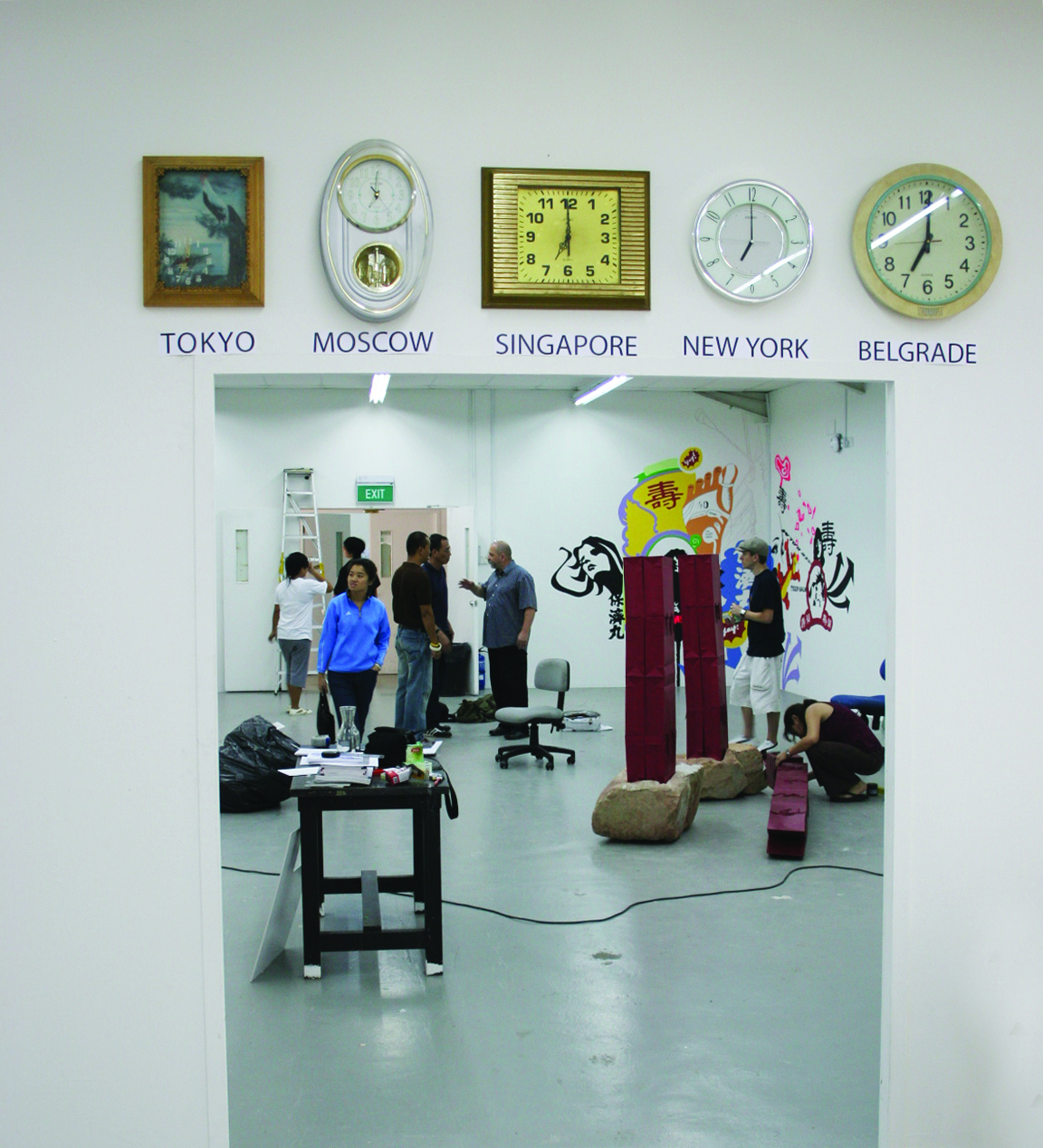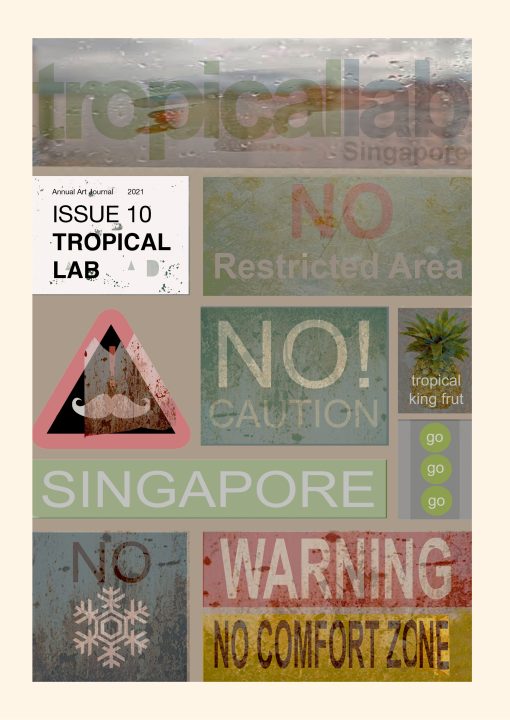Peter Hill
When did Tropical Lab come into existence, and what were its founding ambitions?
Milenko Prvački
As an artist and active citizen, I have always tried to create a special environment, a platform, a stage for artists to extend their own practice out of the comfort zones, in their studios—a communal experience linked to politics. Much of this relates back to my own experience, and memories of my former, native Yugoslavia, and its history.
From 1970 to 1991 I participated annually in one of the most important art symposiums in Yugoslavia. I found it appropriate for that historical moment—a place where artists could create, communicate, share experience, and debate in a friendly environment without judgement of politics and control by politicians.
As such, Tropical Lab grew into a creative Paradise Island with shared commonalities.
After arriving in Singapore 30 years ago, and teaching at LASALLE for the last 27 years, and being totally involved in the twin activities of education and creating art, I began to be continuously preoccupied by the question—how do we create a different space from a traditional art school studio. How do we subvert the traditional curriculum with different activities, and invite outsiders into our Tropical Lab?
Peter Hill
I sense, like me, you like to break down academic hierarchies and also value learning from mistakes. I think playwright Samuel Beckett summed it up best when he said, “Try again, fail again, fail better.”
Milenko Prvački
I can probably best extend these thoughts, contrarily, by first listing what I don’t want Tropical Lab to be: a comfort zone with traditional teaching and a curriculum; a place where assessment is graded; with traditional classrooms and studio classes; a place where the creative process is not valued highly enough.
And here is a list of what I do want Tropical Lab to be:
- An intentionally displaced situation
- An experimental space
- Condensed and stimulating activities
- A sophisticated playground
- A learning environment
- A dialogue
- A collaboration
- A place where innovation is foregrounded
- A group of collectivists that brings individuals together
- A networking hive
- A research hub for knowledge surrounding Asia and Singapore
- A focus on teamwork-driven research
- An annual, peer-reviewed journal of art and ideas that became ISSUE
- Constant Exploration
- A place where ‘mistakes’ are viewed positively

Participants gathering at Prvački’s studio, 2019
Peter Hill
I guess Tropical Lab then becomes a launch pad for the candidates’ future, creative careers, rather than an end-point in their education.
Milenko Prvački
Yes, as a practising artist and educator, I was thinking more about the independent Masters and PhD students, graduating and leaving school forever and starting independent practices without curriculum, teachers, roles, grades, and assessments. It is a great beginning.
I wanted to create a platform for exceptional students who needed more than the ordinary art curriculum that is all too often offered to them, in art schools around the world.
Peter Hill
So how has Tropical Lab, from your initial vision, evolved and expanded over the years?
Milenko Prvački
With the same enthusiasm. I agree with the use of the word ‘evolving’, and I’d add to that: ‘developing’ and ‘extending’. I had to learn from my own mistakes too. And I have learned so much from the participants over the years.
After the exhibition we always do a review, a survey with the participants, collecting information and data about their experience during the art camp. This is valuable information that we will apply and practise in subsequent years as Tropical Lab continues to grow.
I find advice from participants to be very important and it is very welcome. We have to pay attention to source not only good students but students with good communication and collaborative skills.
Connections with government organisations have been crucial too, including the Singapore Tourism Board, Land Transport Authority, Maritime and Port Authority of Singapore and others. They gave us access to visit and explore interesting and relevant sites in Singapore. Because of that relationship, we have been able to explore underground train tunnels—100 metres below street level—that were still under construction; container terminals; and the undeveloped island (Pulau Ubin). We have also been to the astonishing Haw Par Villa, which I know you regard as a wonderful Southeast Asian Superfiction.
Peter Hill
What are your hopes for the forthcoming edition of Tropical Lab?
Milenko Prvački
First, that Covid-19 will end! It is the first requisite to allow us to continue. I am very sad about this current situation. We are doing our best to extend the life of Tropical Lab art camp, and we are missing the participants very much.
Peter Hill
Have you developed any strategies to deal with this?
Milenko Prvački
At the moment, we are creating a web archive which is historically very important. We are doing a retrospective exhibition at the Institute of Contemporary Arts Singapore (ICAS), curated by Anca Rujoiu (and this is being presented in this edition of ISSUE). We are interviewing relevant people, curators, artists, and seminar speakers. The current slowdown has become our period of retrospective thinking and reflection. But I do hope we will do it again next year physically, on campus. That will be of benefit to all, and will lift everybody’s spirits.
Peter Hill
I have a particular research interest in new models of Art Education and alternative forms of knowledge transfer—usually with creativity as its central core. This is why your vision of Tropical Lab has always excited me so much. I especially like those situations where hierarchies are broken down and new models of running, funding, and administrating art schools are explored. I’m thinking of Bruce High Quality Foundation University (BHQFU), a free art school in Brooklyn, and Turps Art School in an old, brutalist housing estate near Elephant and Castle, in South London. They also produce the excellent painting magazine Turps Banana. This art school focuses on the expanded field of painting and is co-directed by Peter Ashton Jones and Marcus Harvey, whose portrait of moors murderer Myra Hindley caused such a sensation at the Royal Academy in 1997. BHQFU also have a winter school in Miami and often drive across America in a bus, a bit like Ken Kesey and his Merry Pranksters, stopping along the way to work with children and young adults on spontaneous art projects. What these two revolutionary art schools have in common is that each evolves its own philosophy. How has your philosophy of both Tropical Lab’s theory and practice influenced its evolution over the years, and this edition of it in particular?

Peter Hill at seminar presentation during Tropical Lab 2019
Milenko Prvački
The only fixed criteria relates to its functioning structure, and the number of invited universities and participants. Everything else is flexible and ever-changing. Firstly, there is the topic and the team. There are two components related to the Tropical Lab art camp: Tropical Lab and our in-house journal ISSUE. We started ISSUE art journal as a research tool that serves as an introduction to the next Tropical Lab, before all participants arrive in Singapore. We invite important and relevant writers, artists, curators, historians, architects, theorists to tackle particular themes. Theory and practice are part of this, not in an educational way but in the professional development of the creative art practice. We do not prescribe any preferred proportion between theory and practice, but we offer options.
Peter Hill
I very much like the non-proscriptive nature of the word “options”. We should always offer options, and the flexibility for change that goes with it. So tell me, how would a particular edition of Tropical Lab unfold?
Milenko Prvački
The first day of the Tropical Lab schedule offers seminars, where we invite local and international speakers to present around a set theme. Ongoing dialogue is a very important introduction to the programme as much as is ISSUE. The second day is allocated for participants’ presentations about their own practices, ideas and concerns. It is also the first opportunity to better know each other. On the third day, participants go on field trips around Singapore—journeys which are organised around and relevant to the set theme of that year. At the same time, they get to know Singapore better. The days follow on with studiowork that culminates in an exhibition at the ICAS, located at LASALLE.
We do not set any restrictions with regards to the ideas, medium, or chosen working methods.
This project fills up a great gap that the educational system does not address. We do not sharpen artists’ ideas but encourage them to be independent and create their own work without educational restrictions and conditions. There may be failed projects, but there are no victims. This leaves plenty of opportunities for self-discovery and learning.

Studio time at the very first Tropical Lab in 2005
Peter Hill
The publication, ISSUE, like the conference, is always based on a theme. Can you sketch in briefly some of the topics you have covered over the years?
Milenko Prvački
Having only two weeks, we have to be very focused. Do not forget that all participants are coming here from different universities, different cultural and educational backgrounds, as well as from different continents. Most of them have never been in Asia; some may have passed through. We create topics based on actuality, relevance and interest. We try to avoid conformism, banality and trend. We are very careful.
Peter Hill
Who else works with you on the programme?
Milenko Prvački
Usually, it is a process that evolves between Dr. Venka Purushothaman and myself. This involves a long preparation and an analytical effort to define and hone the research topic. It must be related to the original idea. It must honour the concept and its universality. It must be relevant to all racial and geographical territories, and of course, to Singapore.
It will contribute to the conceptual core of each Tropical Lab edition, although we do not reject nor try to steer artists’ responses—they are not restricted in any way. Here are the themes we have engaged with since 2005:
Year Theme
2005 Urban – Non Urban
2008 City
2009 Local – Global
2010 Urban Mythologies
2011 Masak Masak
2012 Land
2013 Echo: The Poetics of Translation
2014 Port of Call
2015 Island
2016 Fictive Dreams
2017 Citation: Déjà vu
2018 Sense
2019 Erase
2020 Mobilities
As you can see there is a great diversity of topics, and plenty of room for improvisation, like a good music set. Every theme was relevant to the year in which it happened. We also invite relevant writers, researchers, artists, and curators to write for ISSUE, which as I have said before, is a very important part of Tropical Lab’s research profile. Importantly, it serves as an introduction and stimulus to every camp’s specific theme.

Cruise and learning journey to neighbouring islands of Singapore during Tropical Lab, 2019
Peter Hill
Tropical Lab brings many critical thinkers and creators to LASALLE in Singapore. Does Tropical Lab also go out into the world, and if so, how does this manifest itself?
Milenko Prvački
Each participant carries away Tropical Lab’s values after returning to their own space, their own country and their own art community—which of course includes the social media spaces. Collectively, they are the best communicators for what we do. After 14 years, the Tropical Lab echo is still resonating in many countries, universities, art schools and languages. We are connected with over 30 of the most important art schools in the world, from America, United Kingdom, Europe, Asia, Australia, New Zealand, and Africa.
We are also connected to some of the world’s most significant art events, including documenta at Kassel, the Venice Biennale, the Istanbul Biennale, and REAL PRESENCE, Belgrade. Participants get the opportunity to meet and work with great artists, writers, curators and educators in different capacities. These have included Rirkrit Tiravanija, David Thomas, Peter Elis, Sam Durant, Biljana Tomić, Tony Godfrey, Charles Lim, Dobrila Denegri, Dr. Charles Merewether, Robert Zhao, Bjørn Melhus, Dr. Rhett D’Costa, Anca Rujoiu, Vera Mey, Prof. Chua Beng Huat, and yourself.
We have collaborated on similar projects with universities at Kassel, Belgrade, Beijing, as well as at the Istanbul Biennale and the Venice Biennale.
Peter Hill
I’m keen to hear about your own research interests—both solo works and in collaboration.
Milenko Prvački
This needs a separate chapter (haha). It had been a full 45 years of intensive practice and research. In brief, I started as a figurative, socio-politically engaged painter after graduation in the mid-seventies. However, I realised very soon that I couldn’t compete with much faster, speedier working methods like photography, video, film, and new media. I couldn’t compete in unfolding narratives and in storytelling. My native tongue is Serbian and my second language is German. I studied in Romania, even though I did not speak the Romanian language when I enrolled at their art University. When I arrived in Singapore, I did not speak English; the dictionary was my best friend for years.
I wanted to create works with that structure, the structure of the dictionary. I wanted it to be like a book where the most important notions are in one place—but without stories, without a narrative. It offered me an opportunity and freedom to manipulate visual elements in my own way with my own language. This decision was crucial for me.
In conclusion, I do not have limitations around topics or issues with which I would like to engage. I have no restrictions with regards to the media and the working methods. I am free. I apply this system to my drawings, paintings, prints, collages, sculptures, and installations. The approach to artwork of this nature is very easy to be adapted to collaborative projects. I do these occasionally with my wife Delia, and with musicians and theatre practitioners. But even a two-person exhibition in a gallery is a collaboration, which I might do with a great artist-friend like Ian Woo.
Peter Hill
Can you tell me some of the more memorable times from past Tropical Labs?
Milenko Prvački
Every year is different: different participants, different universities, different interests, different characters, and finally a different look. It is not predictable. So every year is different. Land, Masak Masak, Echo…or showing different sites to participants. I have learned about the geography and history of Singapore from this: Bukit Brown, Pulau Ubin, Container terminals, underground infrastructure—each of these phrases brings back rich memories.
But this should be a question to the artists involved. It was not all smooth sailing; there were a lot of managerial issues that we had to troubleshoot.
Peter Hill
What are your future plans for Tropical Lab?
Milenko Prvački
Primarily, to resume it as soon as possible. Covid-19 stopped any activity for two years.
Tropical Lab is a space that offers an extensive two weeks’ camp of experimentation, exploration, communication, dialogue and after that—it is about growing the network. It never stops with the final exhibition or after they fly back to their own country. After two years of void, I am even more passionate and excited to resume, and can’t wait to encounter again the expectant and happy faces of the participants.
Peter Hill
Finally, I would like to learn a little more about your own history, you have already touched on some of it—from your very un-tropical Serbian beginnings in Eastern Europe, through your journey to Singapore with your talented wife Delia, and the years you have dedicated to energising and inspiring the Singapore art scene.
Milenko Prvački
I was born in a country that does not exist anymore, the very un-tropical Yugoslavia in the time of Tito. I did my Masters in Art in Bucharest, Romania, in the time of Ceausescu in Eastern Europe. Delia and I moved to Singapore in 1991. In this time of transition, my country disappeared in a bloody civil war, and I was left holding a passport to a country that no longer existed. Brother McNally, who founded LASALLE College of the Arts in 1984, invited me to teach there in 1994.
So for the past 27 years, I had stayed in the field of education, and still continue to practise intensively, as I had been doing, along with Delia, my wife who is also an artist, for the last 45 years. As I did in former Yugoslavia (now Serbia) I continue to create projects and platforms for students and artists to develop their talent, to collaborate, as well as to network.
I have been a fortunate witness to the speedy art development in Singapore, and very happy to see the sort of growth that is not usual in the world. As a teacher, nothing makes me more satisfied than to see dependent students coming to LASALLE, then graduating and becoming independent practising artists. They do not need me anymore. Bravo!
I still get excited looking at other artists creating exceptional and valuable artworks. I am there for them to help recognise their potential and quality. That is of great cultural value. Finally, we are here to also highlight and preserve those values.


